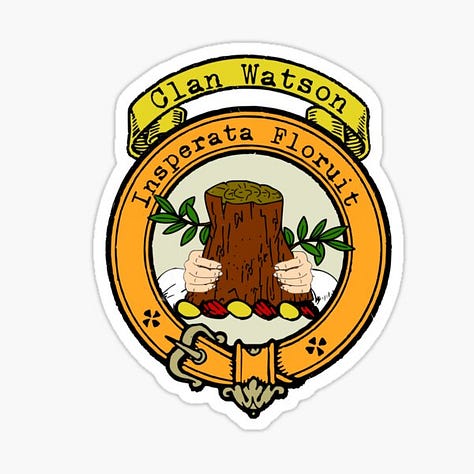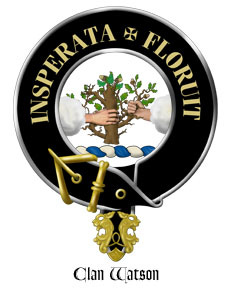Can I use the Clan Watson Coat of Arms?
Information on the Coat of Arms, who can legally use it and the redesigned and corrected "Watson Clan Members Crest".
What is a Coat of Arms?
The coat of arms, is the principal part of a medieval system of hereditary symbols and designs. Used primarily as a means of establishing a knight’s identity in battle, they evolved to denote family descent, allegiance, alliance, property and even profession.
The origin of the term “coat of arms” comes from the cloth tunic worn over armour to shield it from the sun, known as a surcoat. It displayed the arms that were usual also found on the bearers shield and pennon/pendant, and it was particularly useful to the heralds as they scoured the battlefield identifying the dead.
As the military use for coats of arms declined they were gradually adopted by civilians, particularly those of a high status and peerage.
Most coats of arms consist of a shield, helmet, crest and motto. Supporters, which are the figures or beasts standing on either side of the shield, are only granted to particular groups of people, including Clan Chiefs, peers, and senior knights in orders of chivalry.

Who can use the “Watson Coat of Arms”?
A Coat of Arms in Scotland can only belong to a single person at a time and is their legal property. There is no single coat of arms which either belongs to a “the clan” or can be used by its members. The so-called ‘family coat of arms’ is a myth and does not exist in Scotland (nor England for that matter).
So these mugs, t-shirts and keyring that all show the “Watson Coat of Arms” are actually meaningless. It shows “A” Watson’s Coat of Arms.
The example above is that of James Watson Esq. of Saughton, “Chief of the name in Scotland” and the last known Chief of Clan Watson. It is unique to him although heavily based on those that came before him from the Watson of Saughton line.
Coats of arms originated in order to identify a person so common sense dictates that the system wouldn’t work if more than one person could use exactly the same design. Instead Arms must be unique and are usually passed to the heir of the bearer upon their death. Other descendants who bear the same surname often apply for a slightly different version of the arms to be recorded in the Public Register of All Arms and Bearings in Scotland, from which the above example of James’ has been taken.
So to the question “Who can use the Watson Coat of Arms?”, the answer is nobody.
Bearing in mind that heraldry in Scotland, to this day, is a matter of law. They legally belong to James Watson of Saughton who died in 1823 and to our knowledge nobody has been granted these arms by Lord Lyon since. Even if they had been reallocated, they would legally belong to that individual.
Remember when the then US President Donald Trump was accused of using a “stolen coat of arms” at his Golf Course in Aberdeen back in 2017?
How do you identify which Clan you belong to?
Members of a clan, either immediate or distant relatives of the Chief and/or those who profess allegiance to the Chief and wish to demonstrate that association are, with the Chief’s permission, able to wear the Chief’s Crest encircled by a strap and buckle bearing the Chief’s Motto or Slogan.
The strap and buckle are the sign of the clansman, and demonstrates his membership of the Clan shown within.
The crest is a representation of a three-dimensional object and is placed above the helmet that sits on top of the shield on the coat of arms. During tournaments these would be worn on the helmet of the knight to help further with identification.
In the case of James Watson Esq. of Saughton, as the last known recognised Chief of Clan Watson, it is his crest that would be used in this manner. Within the Public Register of All Arms and Bearings in Scotland kept by the Court of Lord Lyon, his crest is blazoned (the term used to describe heraldry) as being:-
“Two hands holding the trunk of one Oak Tree sprouting out fresh branches the hands issuing out of Clouds all proper”.
There are lots of examples of this Clan Members Crest online, sadly many of them are wrong and do not follow the blazon within the register.






Some of the errors introduced in the above examples include no sprouting branches, the hands holding the sprouting branches instead of the trunk as blazoned; the torse (twisted coloured cloth at the bottom of the crest) is displayed in a single colour when it should be doubled, and whilst James’ arms unfortunately make no mention of the colouring of the torse, there is no evidence that Or (Gold), Vert (Green) or Azure (Blue) were ever used by any of James’ ancestors in their arms.
It’s actually been near impossible to find a high quality example of the Clan Watson Crest without any errors that can be used here on Insperata Floruit, by the Clan Watson Society or by Clan members.
So I re-drew it and corrected the errors. With many thanks to both Shane and Kev of the Clan Watson Society (← Official Website) for their advice and sage council on the details.
Watson Clan Members Crest (Re-designed)


“Two hands holding the trunk of one Oak Tree sprouting out fresh branches the hands issuing out of Clouds all proper. Motto Insperata Floruit”.
Torse
Unfortunately, the torse colour is never mentioned in James Watson Esq. of Saughton’s blazon, however we know that in both David Watson of Saughton and his brother John’s it was doubled Gules (Red) and Argent (Silver/White). It’s therefore a reasonable assumption that like many of the other details, James would have remained with this.
Gules, which is heraldic speak for the colour red, represents the warrior or martyr; military strength and fortitude.
Oak Tree
In heraldic symbolism, the Oak Tree represents antiquity and strength. The fact that it’s shown as a stump with fresh sprouting branches was often used as a sign of rebirth or growth. The sprouting branches also feature on the matriculated arms of David Watson of Saughton, James’ 3x Great-Grandfather and on that of David’s brother John. They both matriculated arms with Lord Lyon in 1673.
It’s possible therefore that the Oak Tree represents the ancient line of the Watsons with the sprouting branches the descendants now making their mark on society and indeed on history.
We know from Nisbet the Heraldist that Richard Watson of Saughton re-acquired the lands of Saughton after his family were dispossessed of them for a hundred years, and that according to A.S. Cowper in the paper “The Watsons of Saughton Tombstone: South Aisle” from 1984 that the Watsons of Saughton were believed to have descended from the ancient Watson family of Cranston.
Hands Issuing from Clouds
The use of hands in heraldry is emblematic of faith, with the clouds the symbol of the etherial heights of heaven and consistency.
When used together with he hands issuing out of the clouds this is usually a sign of divinity. The hand of God himself holding and supporting the ancient line of the Clan Watson allowing its rebirth and new growth.
Motto: Insperata Floruit
Translated from Latin as being literally “Unexpectedly Flourishing”.
Both David Watson of Saughton and his direct descendant James Watson Esq. of Saughton used this same motto. David’s brother John on the other hand simply used “Floruit” or flourishing.
The unexpected part of the motto is what interests me. When taken in context, it suggests some sort of near catastrophic event that almost ended or at least damaged the chiefly line of the Watson name.
The trunk of the family was damaged, but with divine support it begins to grow again and sprout new branches. Interesting thought 💭 of course it’s just one of many possible interpretations.





